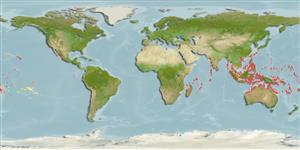>
Anguilliformes (Eels and morays) >
Muraenidae (Moray eels) > Uropterygiinae
Etymology: Uropterygius: Greek, oura = tail + Greek pterygion = little wing. Fin (Ref. 45335).
More on author: Bleeker.
Environment: milieu / climate zone / depth range / distribution range
Ecologie
marien; brak water rifbewoner; diepte 0 - ? m. Tropical; 32°N - 24°S
Indo-Pacific: East Africa to Samoa, north to southern Japan, south to the southern Great Barrier Reef; Marianas in Micronesia.
Grootte / Gewicht / Leeftijd
Maturity: Lm ? range ? - ? cm
Max length : 37.3 cm TL mannelijk / geslacht onbekend; (Ref. 121652); max. gepubliceerd gewicht: 41.50 g (Ref. 121652)
Wervels: 114 - 118. Drab yellow or brown in color, overlain with a web-like network of dark thin lines (Ref. 3257).
Abundant on rubble areas of intertidal reef flats. Feeds on small crustaceans and probably on small fishes as well. Also found in shallow reefs including tide pools (Ref 90102).
Levenscyclus en paargedrag
Maturities | Voortplanting | Spawnings | Egg(s) | Fecundities | Larven
Chen, H.-M., K.-T. Shao and C.T. Chen, 1994. A review of the muraenid eels (Family Muraenidae) from Taiwan with descriptions of twelve new records. Zool. Stud. 33(1):44-64. (Ref. 6934)
Status op de Rode Lijst van het IUCN (Ref. 130435)
Gevaar voor de mens
Harmless
Gebruik door de mens
Visserij: van geen belang
Tools
Speciale rapporten
Download XML
Internetbronnen
Estimates based on models
Preferred temperature (Ref.
123201): 25.8 - 29.3, mean 28.4 °C (based on 2304 cells).
Fylogenetische diversiteitsindex (Ref.
82804): PD
50 = 0.5000 [Uniqueness, from 0.5 = low to 2.0 = high].
Bayesian length-weight: a=0.00046 (0.00028 - 0.00073), b=3.13 (2.99 - 3.27), in cm total length, based on LWR estimates for this species & (Sub)family-body (Ref.
93245).
Trofisch niveau (Ref.
69278): 3.5 ±0.50 se; based on food items.
Weerstandsvermogen (Ref.
120179): Gemiddeld, minimale populatieverdubbelingstijd 1,4-4,4 jaar (Preliminary K or Fecundity.).
Fishing Vulnerability (Ref.
59153): Low to moderate vulnerability (27 of 100).
